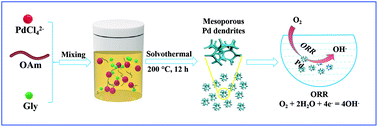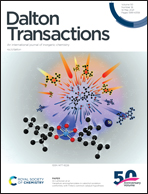One-pot synthesis of mesoporous palladium/C nanodendrites as high-performance oxygen reduction eletrocatalysts through a facile dual surface protecting agent-assisted strategy†
Abstract
Palladium (Pd) is regarded as a potential non-platinum electrocatalyst to drive oxygen reduction in fuel cells. The development of Pd-based electrocatalysts with high performances through structural engineering is still highly desirable. Herein, a facile one-pot synthesis strategy with the assistance of dual surface protecting agents was developed to fabricate carbon-supported Pd (Pd/C) nanodendrites with high mesoporosity. The mesoporous spherical Pd/C nanodendrites are built with connected nanoparticles with a small size of several nanometers and coated by simultaneously formed carbon layers. The used dual protecting agents, glycine and oleylamine, exhibit synergistic effects to engineer Pd growth to form the unique mesoporous dendritic structure. Benefiting from the mesoporous feature, small size, defect-rich surface and carbon coating, the obtained mesoporous Pd/C nanodendrites exhibit great electrocatalytic performance toward the oxygen reduction reaction (ORR).



 Please wait while we load your content...
Please wait while we load your content...